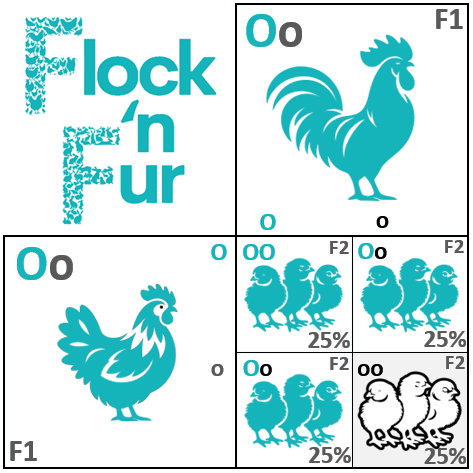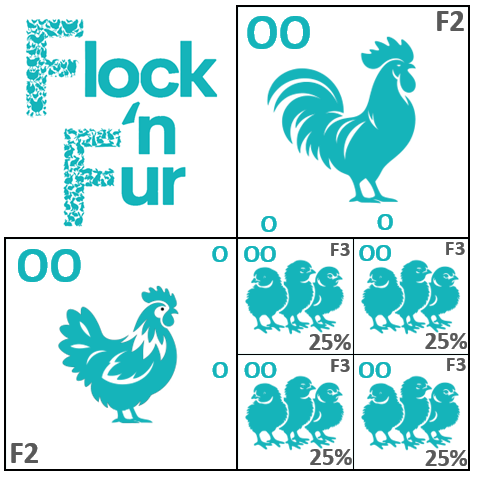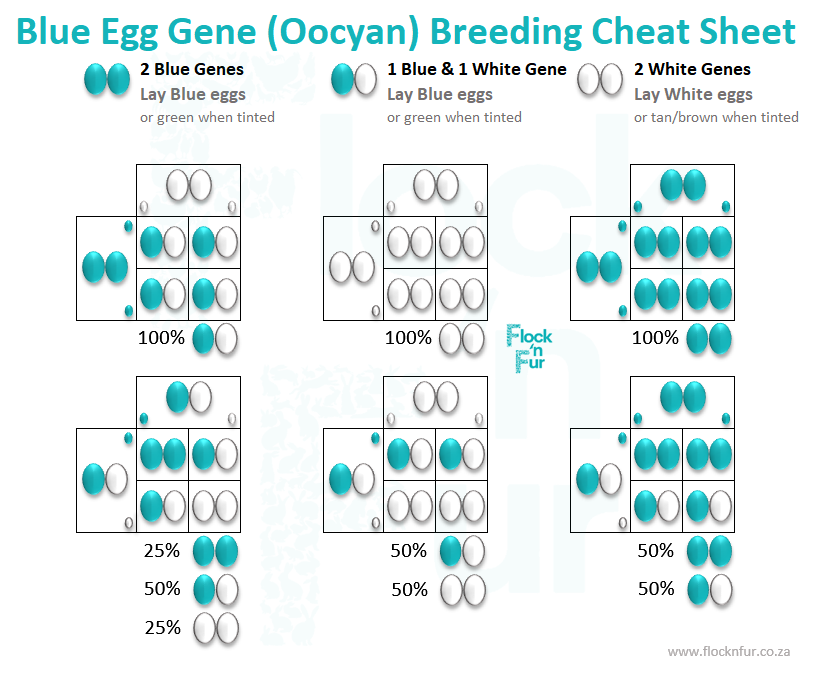Creating Your Own Easter Egger Cross
In most instances, when creating Easter Eggers, the objective is to produce chickens that lay exclusively green and blue eggs. This necessitates breeding chickens with two copies of the blue egg gene (Oocyan, sometimes spelled as Oocyanin). However, if your aim is a broader spectrum of egg colours, breeding for exclusivity is not required.
Embarking on your own Easter Egger cross is, effectively, a significant multi-year breeding project. The goal is to breed chickens that consistently lay blue eggs.
In this article, we delve into how to breed and test for two copies of the blue egg gene. It would be to your advantage to first familiarise yourself with the article on Easter Eggers and the Blue Egg Gene. Due to the gene’s dominance, identifying (and thus excluding) offspring carrying only one copy proves challenging. The process described here can be used to breeding for any dominant trait.
As the presence of the blue egg gene can only be verified in hens once they commence laying, this becomes a protracted process spanning multiple years over several generations of chickens.
Starting Point
Start off with a breed known to carry two blue egg genes, or at least an Easter Egger confirmed to possess two blue egg genes. When crossed with a breed devoid of any blue egg genes (white eggshells), 100% of the first-generation (F1) offspring will inherit one blue gene and one white gene as shown in the Punnett square below.

Keys for this Punnett square:
‘O‘ represents the dominant gene for blue eggshells (oocyan).
‘o‘ represents the recessive gene for white eggshells.
‘OO‘: Possessing two copies of the blue egg gene indicates a homozygous genotype for blue eggshells.
‘oo‘: Possessing two copies of the white egg gene indicates a homozygous genotype for white eggshells.
‘Oo‘: Possessing one copy of each gene (blue and white) indicates a heterozygous genotype.
F0: Initial parent stock.
F1: First generation cross.
Note that ‘white eggshells’ refers to eggs from white to tan, pink, and dark brown. The shell itself is white on the inside; colours such as tan and brown are the result of surface pigments added during the laying process. There are fundamentally only two basic eggshell colours: pure white and blue.
Breeding the Second Generation (F2)
The second generation (F2) is produced by breeding different F1 chickens from your first cross (where each parent carries one blue and one white egg gene). This doesn’t necessarily mean you have to cross brothers and sisters. You can breed multiple F1 groups produced from different pairings of your original (F0) generation.
The F1 x F1 cross will have the probability for the following offspring distribution:
- 25% with two blue genes: Hens will lay blue eggs.
- 25% with two white genes: Hens will lay white (non-blue) eggs, confirming they do not carry the blue egg gene.
- 50% with one blue and one white gene: Hens will lay blue eggs (due to the dominant blue gene), but they carry the recessive white egg gene.
This is demonstrated by the following Punnett square:

25% of the offspring possessing two copies of the white egg gene.
50% of the offspring possessing one copy of each gene (blue and white).
Keys for this Punnett square:
‘O‘ represents the dominant gene for blue eggshells (oocyan).
‘o‘ represents the recessive gene for white eggshells.
‘OO‘: Possessing two copies of the blue egg gene indicates a homozygous genotype for blue eggshells.
‘oo‘: Possessing two copies of the white egg gene indicates a homozygous genotype for white eggshells.
‘Oo‘: Possessing one copy of each gene (blue and white) indicates a heterozygous genotype.
F1: First generation cross.
F2: Second generation cross.
Testing for Blue: Finding the 25% that carry two blue genes
Now, you need to ascertain which of the F2 birds (including roosters) carry two blue genes. It’s not practical nor necessary to test every single rooster or every hen that lays green or blue eggs. Select a few for initial testing. If these chickens do not produce the desired results, repeat the testing cycle with a different group to avoid excessive costs.
First, you can eliminate any hens that do not lay blue or green eggs, as they do not carry the blue egg gene. Another useful guide for narrowing your testing group is the colour of the chicken’s earlobe. Chickens carrying the blue egg gene often (though not always) have a bluish tint to their earlobes. (Note that the colour of the earlobes is determined by over a dozen genes and is not always accurate, but serves as an indication.) This visual cue can aid in selecting chickens to test for the blue egg gene.
Once you’ve selected a few hens and roosters that you want to test for the blue egg gene, you have 2 options for this test:
Both options can be costly, and you will have to weigh up the cost of feed and housing a lot of offspring with the price of the lab test. Do note that the lab test will save you a lot of time and thus speed up the process significantly.
Locking the Genetic Line
F2 chickens that produce 100% blue/green-laying hens (in your test generation) or tested homozygous for the blue egg gene are the 25% carrying two blue genes. Cross these second-generation (F2) birds to breed your third generation (F3). From here onwards, your offspring should consistently carry two blue genes and thus breed true for egg colour.

Keys for this Punnett square:
‘O‘ represents the dominant gene for blue eggshells (oocyan).
‘OO‘: Possessing two copies of the blue egg gene indicates a homozygous genotype for blue eggshells.
F2: Second generation cross.
F3: Third generation cross.
An alternative approach
See the Blue Egg Gene Breeding Programme for guidance on how to stabilise the blue egg gene in an existing flock or breed.
The (ir)relevancy of F2, F3, F4+ claims
The distinction between F2, F3, F4, and subsequent generations of Easter and Olive Eggers often becomes a point of emphasis among breeders, implies a level of precision and predictability in egg colour. However, without a rigorous and methodical breeding process akin to the one outlined in this article, such claims hold little to no substantive value. Simply advancing through generations without a deliberate strategy to solidify the blue egg gene—or any other trait—does not guarantee the perpetuation or enhancement of the desired characteristics. It’s crucial to understand that the true merit in these classifications lies not in the generational label itself, but in the meticulous selection and breeding practices employed to achieve consistent and predictable outcomes. Without adherence to a structured approach, the generational tags become mere numbers, devoid of the genetic assurance they might otherwise imply. Hence, when evaluating or discussing the quality and characteristics of Easter and Olive Eggers, the focus should remain on the breeding strategy and genetic composition rather than on the generational number alone.
In Summary: The Cheat Sheet

